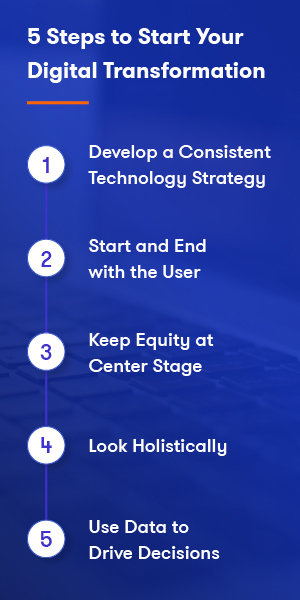Digital transformation, the use of technology to make business processes more efficient, improve user experiences, and meet the cultural demands for equity, is no longer something to be done in the future. After the pivot to doing almost everything online due to the global COVID-19 pandemic, digital transformation is now a necessity in every field.
Britt Nichols, SVP at ExamSoft and an experienced leader in the education space, outlines five crucial steps for beginning a digital transformation at your institution in a recent article from Authority Magazine.
1. Develop a Consistent Technology Strategy
When every member of an organization uses the same digital tools, digital transformation is much smoother. In higher education, instructors, administrators, and students using one platform can ease any potential pain points before they become a problem. There’s no need to switch back and forth between platforms with each class, for example. With a more efficient solution in place, students can focus on learning and instructors can focus on teaching.

2. Start and End with the User
User experience and expectations should always be top of mind when considering digital transformation. As more and more of everyday life happens in the digital space, we expect everything to be just as convenient and functional. Education is no different. When you know what the end user (students and teachers) needs, it’s much easier to deliver those services.
3. Keep Equity at Center Stage
One of the main benefits of digital transformation is the ability to increase equity. Varied strengths and backgrounds among students can make creating an equitable experience difficult in the best of situations. Software platforms like ExamSoft work to level the playing field, giving instructors the ability to provide early remediation to the students who need it, for example. Students get specific feedback on what content areas they may be struggling with. With these strategies in place, learning outcomes improve across the board.
4. Look Holistically
Many organizations make the mistake of rolling out digital solutions one at a time, but this creates a lack of cohesion, which trickles down to the user. It’s important to examine the needs of your entire organization and build a digital foundation that serves all departments, teams, and end users. Otherwise, you’ll always be a step behind the leading edge of technology and culture at large.
5. Use Data to Drive Decisions
After building a digital foundation for your organization, it’s important to continually look at the data. What’s working and what’s not? The data will inform decisions about changes you can make to overcome challenges, while also showing you where your digital efforts are succeeding.
While digital transformation may seem overwhelming, it’s no longer an option or something to address further down the road. The time is now. As you begin your journey — or continue it — be consistent, keep the end user in mind, stay focused on equity, look at the whole picture, and use the data that digital technology can provide.






